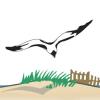Historically, the beaches of Delaware Bay have been the scene of the world's largest concentration of spawning horseshoe crabs, and the largest and most important stopover for shorebirds on the Eastern Seaboard of the United States. That distinction remains, although the numbers of both horseshoe crabs and shorebirds have decreased significantly as a result of ongoing fishing practices. Mounds of horseshoe crab eggs that shorebirds feasted on were once visible covering long stretches of the Delaware Bay shoreline. Visible egg masses are now a distant memory. Shorebirds that numbered over a million as recently as the late 1980s are now a small fraction of that number.
The shorebird that is in the most concerning decline is the red knot, a delicate bird that weighs less than a smartphone yet somehow manages to make a 9,500-mile journey between the extremes of two continents twice a year. Until recently, the red knot could reliably be seen along the Delaware bayshore in May during its northern migration. The U.S. Fish and Wildlife Service continues to list the red knot, Calidris canutis rufa, as threatened under the Endangered Species Act, since it is showing no sign of recovery from its near-disappearance following the overharvest of horseshoe crabs during the 1990s. It is likely to become in danger of extinction in the foreseeable future unless consequential actions are taken to reverse its decline.
Humans have a long history of pushing animals over the edge. Bird species that have gone extinct in the last two centuries due to human causes include the passenger pigeon and great auk, both of which once numbered in the millions. What would it mean if we lost the red knot?
Fishing interests responsible for the recent near-extirpation of the horseshoe crab from the Delaware Bay during the 1990s are using overly optimistic assumptions about population status to justify the continuing removal of the scraps that remain. As recently as last year, the agency representing fishing interests attempted to expand the recommended horseshoe crab harvest to include females, even though its own data showed an alarming decline in the number and size of female horseshoe crabs. The expansion of the harvest to include females was not advanced only because of overwhelming public opposition. However, the agency has clearly indicated that it has the option to promote a female harvest in the future.
An independent study conducted in 2022 by Romuald N. Lipcius of the Virginia Institute of Marine Science concluded that the current management strategy has not been effective, that population dynamics are not well understood, and that the harvest of horseshoe crabs should not be increased to include females. That is why Delaware needs a law to permanently prohibit the harvest of female horseshoe crabs in Delaware waters, regardless of what the fisheries agency recommends.
The Delaware General Assembly formed the Delaware Native Species Commission in 2018 to continue the work of the Statewide Ecological Extinction Task Force, and to implement its recommendations. One key recommendation is to reverse the trend of decline and extinction of Delaware's local plant and animal native species. The red knot is likely to have been an annual Delaware visitor for centuries, if not millennia. In just the past few decades, aerial surveys have indicated that the red knot population has decreased from 150,000 to an average of less than 10,000 for the past two years, dangerously approaching the point of no return. Decisive action to protect the threatened red knot will be a crowning achievement of both the assembly and the commission.
Steve Cottrell is president of the Delaware Audubon Society.





















































